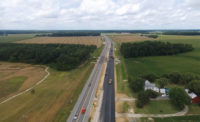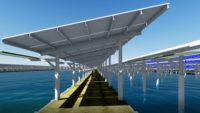Conference Reaffirms Strength of Design-Build Delivery

DBIA 'Founding Fathers', from left, Don Warren, Rik Kunnuth, Jim Gray and Preston Haskell. Photo by Pam Radtke Russell.
Design-build—occasionally thwarted by confusing laws, team members unfamiliar with the concept, or owners who want to use the delivery method only to reduce their risk—is still the best way to deliver projects faster and with lower costs, the founding members of the Design-Build Institute of America said during DBIA’s 25th annual conference.
“It’s better faster cheaper,” said Don Warren of McCrory Construction, one of four of the DBIA’s five founding members who spoke during a general session at the conference in New Orleans.
Those thoughts were validated by new research released during the conference. The new study reaffirmed a 1998 study by the Construction Industry Institute that found design-build (DB) had lower costs and schedule growth and faster delivery speed than design-bid-build (DBB) or construction-manager-at-risk (CMR) methods. That “bellwether” study helped change state policy, said Keith Molenaar, an associate dean at the University of Colorado Boulder who worked on both studies.
“Design-build is truly outperforming the other methods,” Molenaar said.
The updated study examined a variety of 212 projects using the different delivery methods and found that design-build projects are 1.9% less expensive that CMR on a square foot basis, and .3% less than DBB. DB projects also had 2.4% less cost growth than CMR and 3.8% less than DBB. DR projects are delivered 61% faster than CMR and 102% faster than DBB.
The study found success was linked to how well the owner set and communicated their expectations and if the designer and builder had worked together on previous projects.
“No matter how it was achieved, there was a theme of developing a relationship,” says Bryan Franz, an assistant professor the University of Florida who worked with Molenaar on the study.
Poor project performance was generally caused by a lack of experience with the project delivery system, poor communication between owner and builder, and turnover.
By creating DBIA, the founding members hoped to emphasize best practices and avoid poor performance.
“It starts with trying to get to know each other and motivate each other and getting on the same page,” said DBIA founding steering committee member Rik Kunnath of the Pankow Foundation. “It’s understanding the value that each piece brings to the project.”
Jim Gray of Gray Construction said even if design and engineering is outsourced in the DB model, the key is having relationships that have developed over time.
Words from DBIA Founders
Kunnuth, Warren, Gray and Preston Haskell of Haskell discussed how several like-minded individuals in the construction industry got together in the 1990s to begin exchanging best-practices about design-build, which was already in use, but wasn’t necessarily understood by everyone.
“Many ideas are often born and shaped out of frustration,” Gray said. “We were spending a lot of time in Japan, and the Japanese construction industry is framed around design-build.” But Gray says he couldn’t get domestic clients to accept the delivery method.
“We had to convince the owners that the fox wasn’t in the henhouse,” Warren said.
Gray said Haskell took the “bull by the horns” and set up an initial meeting of 13 companies to discuss creating a design build organization.
“There was a consensus at that first meeting,” Haskell said. “There was a clear concept from the outset.”
The group created DBIA and focused not only on best practices, but also on technical details such as standardized forms, education and licensure.
Not Solely For Risk Transfer
But 25 years later, there are still obstacles, says Kunnath, especially from owners who simply want to use the method to transfer risk. “If it’s just going to be a risk transfer, and you don’t extract the value of team cooperation and enlightened design—it’s not a lot of fun, and in those cases, it can be worse than just being a bidder. If it’s just risk transfer, walk away,” he advised the audience.
Still, design build is growing as a delivery method as owners are looking to do more with less, said Paul Trombitas of FMI who gave conference-goers a glimpse of DB trends. According to FMI, DB will see 18% annual growth over the next three years and will capture 44% of construction spending by 2021.
“Design-build is no longer an alternative,” he said. “It’s just the way we deliver.”




